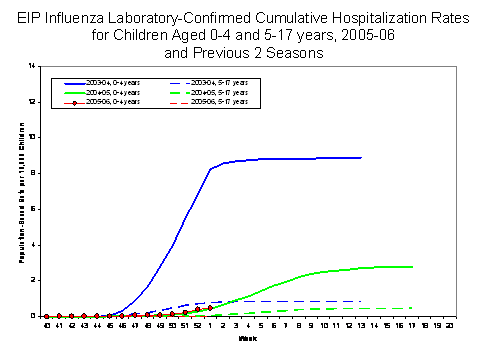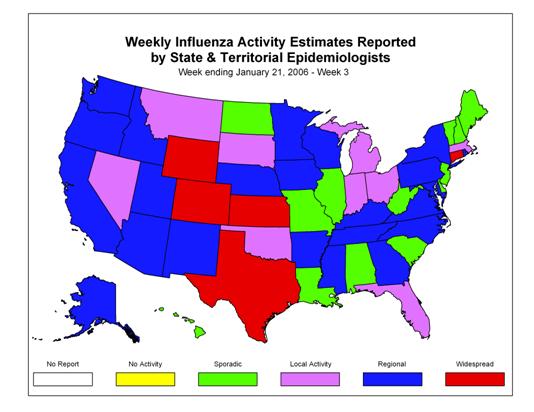Error processing SSI file
Error processing SSI file
Weekly Report: Influenza Summary Update
Week ending January 21, 2006-Week 3
Error processing SSI fileSynopsis:
During week 3 (January 15 ?January 21, 2006)*, influenza activity continued approximately at the same level as recent weeks in the United States. Two hundred forty-seven specimens (10.8%) tested by U.S. World Health Organization (WHO) and National Respiratory and Enteric Virus Surveillance System (NREVSS) collaborating laboratories were positive for influenza. The proportion of patient visits to sentinel providers for influenza-like illness (ILI) was above the national baseline. The proportion of deaths attributed to pneumonia and influenza was below the baseline level. Five states reported widespread influenza activity; 23 states and New York City reported regional influenza activity; 9 states and the District of Columbia reported local influenza activity; and 13 states reported sporadic influenza activity.
Laboratory Surveillance*:
During week 3, WHO and NREVSS laboratories reported 2,283 specimens tested for influenza viruses and 247 (10.8%) were positive. Of these, 81 were influenza A (H3N2) viruses, 159 were influenza A viruses that were not subtyped, and 7 were influenza B viruses.
Since October 2, 2005, WHO and NREVSS laboratories have tested a total of 50,688 specimens for influenza viruses and 3,000 (5.9%) were positive. Among the 3,000 influenza viruses, 2,904 (96.8%) were influenza A viruses and 96 (3.2%) were influenza B viruses. One thousand three hundred eighty-eight (47.8%) of the 2,904 influenza A viruses have been subtyped: 1,381 (99.5%) were influenza A (H3N2) viruses and 7 (0.5%) were influenza A (H1N1) viruses. Forty-six states from all surveillance regions** have reported laboratory-confirmed influenza this season. Nine hundred nineteen (30.6%) of the 3,000 isolates have been reported by the Mountain region and 684 (22.8%) have been reported by the Pacific region.
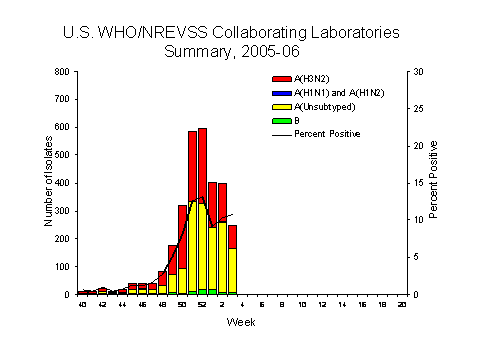
View
Chart Data |
View
Full Screen
Antigenic Characterization:
CDC has antigenically characterized 144 influenza viruses [132 influenza A (H3N2), 1 influenza A (H1), and 11 influenza B viruses] collected by U.S. laboratories since October 1, 2005. Of the 132 influenza A (H3N2) viruses, 112 were characterized as A/California/07/2004-like, which is the influenza A (H3N2) component recommended for the 2005-06 influenza vaccine, and 20 showed reduced titers with antisera produced against A/California/07/2004. The hemagglutinin protein of the influenza A (H1) virus was similar antigenically to the hemagglutinin of the vaccine strain A/New Caledonia/20/99. Influenza B viruses currently circulating can be divided into two antigenically distinct lineages represented by B/Yamagata/16/88 and B/Victoria/2/87 viruses. Eight of the influenza B viruses characterized belong to the B/Yamagata lineage. One was similar to B/Shanghai/361/2002, the recommended influenza B component for the 2005-06 influenza vaccine, and 7 were characterized as B/Florida/07/2004-like. B/Florida/07/2004 is a minor antigenic variant of B/Shanghai/361/2002. Three influenza B viruses were identified as belonging to the B/Victoria lineage.
Pneumonia and Influenza (P&I) Mortality Surveillance*:
During week 3, 7.4% of all deaths reported by the vital statistics offices of 122 U.S. cities were due to pneumonia or influenza. This percentage is below the epidemic threshold of 8.2% for week 3.
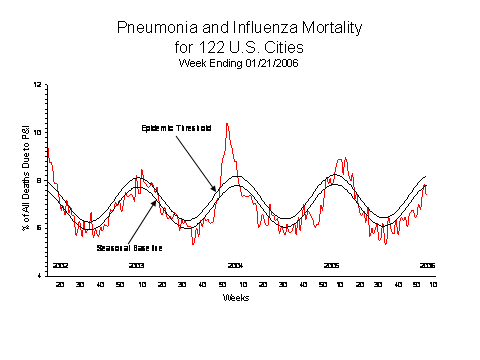
Influenza-Associated Pediatric Mortality*:
One influenza-associated pediatric death was reported during week 3. Since October 2, 2005, CDC has received reports of 11 influenza-associated pediatric deaths, 9 of which occurred during the current influenza season.
Influenza-Associated Pediatric Hospitalizations*:
Laboratory-confirmed influenza-associated pediatric hospitalizations are monitored in two population-based surveillance networks? the Emerging Infections Program (EIP) and the New Vaccine Surveillance Network (NVSN). During October 1, 2005 ?January 7, 2006, the preliminary influenza-associated hospitalization rate reported by the EIP for children aged 0-17 years was 0.18 per 10,000. For children aged 0-4 years and 5-17 years, the rate was 0.48 per 10,000 and 0.02 per 10,000, respectively. During October 30, 2005 ?January 7, 2006, there were no laboratory-confirmed influenza-associated hospitalizations for children 0-4 years old in the NVSN. EIP and NVSN hospitalization rate estimates are preliminary and may change as data continue to be collected.
Influenza-like Illness Surveillance*:
During week 3, 2.3%*** of patient visits to U.S. sentinel providers were due to ILI. This percentage is above the national baseline of 2.2%. The percentage of visits for ILI ranged from 0.9% in the New England region to 6.0% in the West South Central region**. Due to wide variability in regional level data, it is not appropriate to apply the national baseline to regional level data.
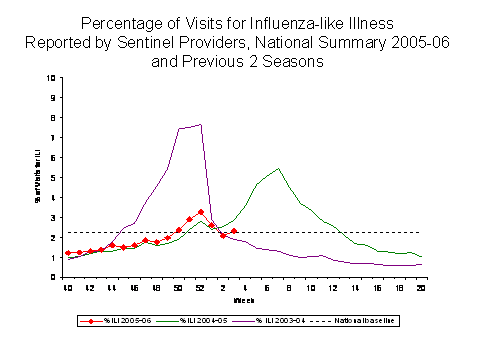
View
Chart Data
| View Full Screen
Influenza Activity as Assessed by State and Territorial Epidemiologists*:
During week 3, 5 states (Colorado, Connecticut, Kansas, Texas, and Wyoming) reported widespread influenza activity. Twenty-three states (Alaska, Arizona, Arkansas, California, Georgia, Idaho, Iowa, Kentucky, Maryland, Minnesota, Mississippi, Nebraska, New Mexico, New York, North Carolina, Oregon, Pennsylvania, Rhode Island, Tennessee, Utah, Virginia, Washington, and Wisconsin) and New York City reported regional influenza activity. Nine states (Florida, Indiana, Massachusetts, Michigan, Montana, Nevada, Ohio, Oklahoma, and South Dakota) and the District of Columbia reported local influenza activity. Thirteen states (Alabama, Delaware, Hawaii, Illinois, Louisiana, Maine, Missouri, New Hampshire, New Jersey, North Dakota, South Carolina, Vermont, and West Virginia), reported sporadic influenza activity.
--------------------------------------------------------------------------------
Report prepared January 27, 2006
Error processing SSI file